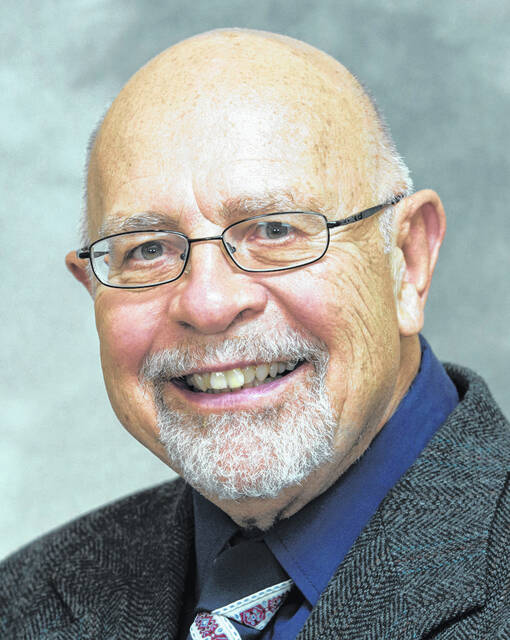
Near Darke
By Hank Nuwer
On July 24, 1902, the Greenville Democratic Advocate (forerunner to the Daily Advocate) bade a fond farewell to some leading citizens headed on the social adventure of their lives to to see Alaska’s gold boomtowns by rail.
They were middle-aged, well established and wealthy, but adventuresome. The saints of Greenville surely encountered rough miners, illegal bawdy houses, and colorful characters in their base camp at Sitka.
Why saints?
Because tall these business leaders provided a legacy of donations to Darke County, particularly Greenville, that outlived them.
The first couple was Henry and Ella S. Van Dyke St. Clair, wealthy merchants dealing in produce, groceries and other wholesale goods. St. Clair was a New York State native whose parents brought him at age three to Darke County. St. Clair’s bride Ella married him at 22 in 1875. He and his wife were childless.
Eight years after starting his trade in Darke County, he had annual receipts upward of $200,000 in 1878 dollars, according to W. H. McIntosh’s 1880 “The History of Darke County.”
That’s a lot of peddled fruit and cabbages.
A lover of books and reading, St. Clair donated funds out of pocket to cover a whopping $30,000 in extra costs for a new Carnegie Library expansion in Greenville in 1901 not included in grant moneys donated by philanthropist Andrew Carnegie. Without the donation, the Carnegie Library in Greenville would have been a fragment of its present grandeur.
In his will, after a premature death from illness in 1905, St, Claire donated $100,000 to the Greenville Board of Education for an assembly hall worthy of fine performances for students and faculty to enjoy. When it too was running ridiculously over budget and its future imperiled, the saintly Mrs. St. Clair covered a whopping construction and architect bill for the exquisite Henry St. Clair Memorial Hall with funds from her own inheritance.
Mrs. St. Clair outlived her husband by many years. After her death on December 31, 1927, relatives seemingly crawled out of the woodwork to challenge her will. But in the end, the courts supported her wishes.
Also on that memorable Alaska trip were Mr. and Mrs. George W. Studebaker.
Like Mr. St. Clair, Studebaker died just a few years after that memorable Alaska excursion.
His legacy was that he was the son of one of Greenville’s first settlers and cabin builders. In 1878, he rose to the president of Farmer’s National Bank that has started 12 years previously. He worked every week in the bank until his heart gave out in 1906.
Born on a homestead in 1832, Studebaker was a community activist who singlehandedly organized a petition drive in 1902 to pave Greenville’s streets as automobiles replaced horse and buggies.
The final member of the Alaska adventure party was Mrs. W. S. Richeson. She was the widow of a wealthy Greenville drain tile manufacturer who died in 1897 after a failed surgical intervention.
The two of them were leaders in the Darke County temperance movement. They believed in their hearts that intoxication destroyed families and needed to be regulated.
All of them, but particularly Mr. and Mrs. St. Clair, did such great deeds for Darke County that I can only hope they had the time of their lives in Alaska. Blessed be they, the saints of Greenville.
Today’s column has a symbolic byline of Everywhere, Alaska, as it was written just before we took off for our vacation state.
If all has gone well the last three weeks, Gosia and I have traveled many hundreds of miles in Alaska by plane and automobile.
We’ve pleasantly frozen in Kotzebue above the Arctic Circle, a city with such high crime that it is a staple on many episodes of Alaska State Troopers.
We’ve also visited chilly Salmon Bay just above the Aleutians where few live. We wanted to experience a near ghost town in October as the surrounding waters ice over.
Then there is us in the Kenai area where we hope to see the last bears before they hibernate. I hope the trout and salmon were plentiful as we lodge in a one-room dry cabin with only a wood stove for heating and cooking. We’ll also spend the last days of the trip in the bush north of Tok, Alaska, where we plan to walk every centimeter of our long-owned 15 acres.
Gosia and I will be home soon, our Alaska urges met until 2022.
In my mind’s eye, I can see those middle-aged folks on an excursion in 1902, experiencing the last vestige of the Alaska Wild West in its most exciting, rowdy time period.
If only my wife and I had a time machine, we’d go back to 1902 and accompany them.
Hank Nuwer is an author, columnist and playwright. He and wife Gosia live on the Indiana side of the Union City state line. Viewpoints expressed in the article are the work of the author. The Daily Advocate does not endorse these viewpoints or the independent activities of the author.




